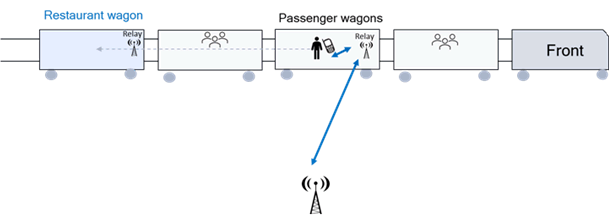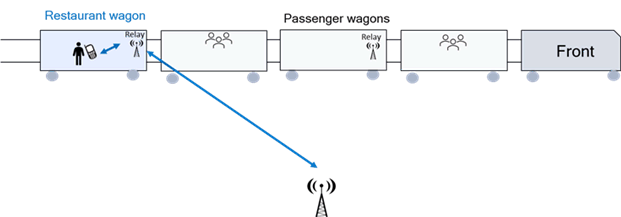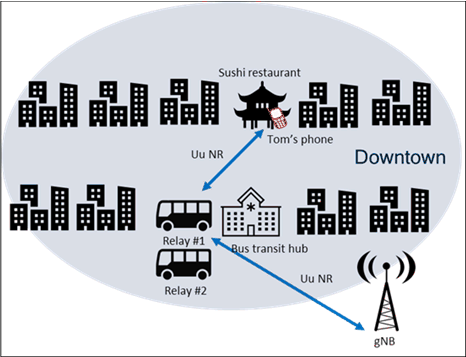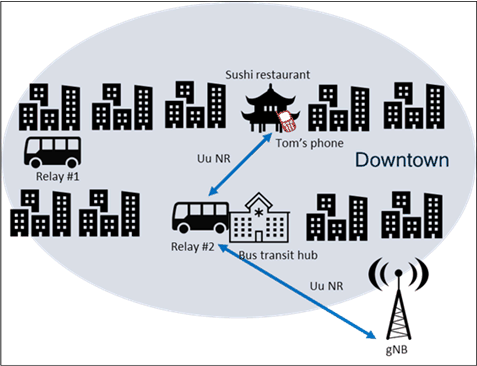Content for TR 22.839 Word version: 18.1.0
5.11.3 Mobility between relays
5.11.3.1 Use case 1: User inside the vehicle
5.11.3.2 Use case 2: User outside the vehicle
...
...
5.11.3 Mobility between relays p. 29
5.11.3.1 Use case 1: User inside the vehicle p. 29
5.11.3.1.1 Description p. 29
Some big size vehicles, e.g. trains or trams, can require multiple 5G base station relays to provide good coverage to users/UEs located in different parts of the vehicle. In such cases, if active users/UEs move around the vehicle their connection can switch between different relays.
In the example described hereafter, Tom is travelling on a high-speed train that provides 5G on board coverage (from his HLMN) by using relays installed 2-3 wagons apart, connected via wireless backhaul to the wide-area 5G macro RAN.
5.11.3.1.2 Pre-conditions p. 29
Tom is seating on the train and his smartphone is camped on a local (HPLMN) 5G relay inside/nearby his wagon. It's almost lunch time, and he's thinking to go and eat something at the small restaurant/bar available on the train, located few wagons away. Meanwhile, Tom receives a video-chat call from his wife.

5.11.3.1.3 Service Flows p. 30
1)
Tom has started a call, using 5G connectivity from the close-by 5G relay (e.g. inside his wagon)
2)
During the call, Tom moves to the restaurant wagon, which is covered by another 5G relay.
3)
While moving between wagons, connectivity quality/strength of the first relay decreases, while coverage from the relay in the restaurant wagon becomes available and stronger.
4)
When Tom gets closer to restaurant wagon, the call is handed over from the first relay to the second relay, using the same donor macro node.
5.11.3.1.4 Post-conditions p. 30
Tom arrives at the restaurant without perceiving any disruption to the ongoing call and can continue enjoying his phone conversation while seating at the bar.

5.11.3.1.5 Existing features partly or fully covering the use case functionality p. 30
Current requirements (e.g. related to wireless self-backhaul, see clause 6.12 of TS 22.261) or existing functionalities (e.g. IAB), cover scenarios of autonomous configuration/adaptation of network topologies, but do not assume or fully address physical relay mobility.
5.11.3.1.6 Potential New Requirements needed to support the use case p. 31
[PR 5.11.3-1]
The 5G system shall be able to support efficient handover when a UE active communication changes between mobile base stations relays (e.g. mounted on a vehicle), ensuring end-to-end service continuity during mobility of the UE (e.g. moving inside the vehicle).
5.11.3.2 Use case 2: User outside the vehicle p. 31
5.11.3.2.1 Description p. 31
While a user is located in an area where coverage from mobile base station relay(s) is available, the user's UE can be handed between mobile base station relays due to mobility of the relays. Ensuring that that there is no interruption in the ongoing services at the UE during such handover will yield an improved user experience.
5.11.3.2.2 Pre-conditions p. 31
Tom has made plans to have lunch with friends at a sushi restaurant downtown. The food there is very good, plus the restaurant is conveniently located across from the downtown bus transit hub/station, which enables Tom to reach the restaurant easily by public transportation. All buses in Tom's city are equipped with mobile base station relays.
Tom arrives early at the restaurant and sits down at a table. His phone registers with the mobile base station relay mounted on a bus across the street awaiting departure. Tom starts streaming his favorite TV show on his phone while waiting for his friends.

5.11.3.2.3 Service Flows p. 31
1)
The driver of the bus equipped with the mobile base station relay serving Tom's phone gets in the bus and prepare to depart. The driver turns on the engine, closes the doors, and starts driving the bus toward the exit of the bus transit hub, then makes a left into the avenue.
2)
The network determines that the serving relay is moving away from Tom's phone and hands over Tom's phone to a relay located in another bus awaiting departure at the bus transit hub. All ongoing services in the phone, including the streaming of the TV show, are transferred without service interruption.
3)
Tom's friends arrive at the restaurant, and they order lunch.
5.11.3.2.4 Post-conditions p. 32
Tom's streaming video was transferred seamlessly from the mobile base station relay mounted on the first bus, to a mobile base station relay mounted the second bus. Tom is very pleased that he was able to watch his TV show without interruption while he was waiting for his friends.

5.11.3.2.5 Existing features partly or fully covering the use case functionality p. 32
Current requirements (e.g. related to wireless self-backhaul, see clause 6.12 of TS 22.261) or existing functionalities (e.g. IAB), cover scenarios of autonomous configuration/adaptation of network topologies, but do not assume or fully address physical relay mobility.
5.11.3.2.6 Potential New Requirements needed to support the use case p. 32
[PR 5.11.3-2]
The 5G system shall be able to support efficient handover when a UE active communication changes between mobile base stations relays (e.g. mounted on a vehicle), ensuring end-to-end service continuity during mobility of the UE (e.g. moving outside the vehicle) and/or the relays.